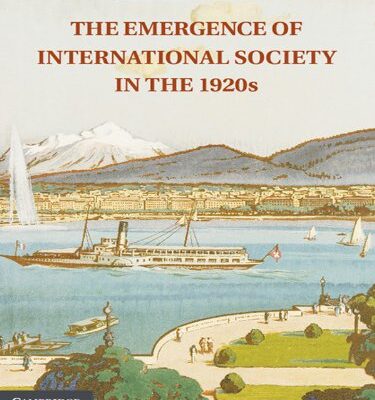
Daniel Gorman’s The Emergence of International Society in the 1920s tells the story of how World War I created an international community that connected the globe. In the aftermath of the Great War, the nations of the world were as disconnected as ever. Many had been ravished by the war, while those not directly involved were being abused by the powerful colonial superpowers. With the coming of the new decade, these superpowers would collide with each other to create an international society. As Gorman puts it himself, “the shock of the First World War gave rise to a broad array of overlapping initiatives in international cooperation.”

Summary
Gorman’s 1920s monograph takes a look at the decade from an Anglo-American point of view. His aim is to explore how and why World War I was able to rapidly create a large international society and how Britain and Anglo-Americans were able to influence it. The book is split into two sections. The first explores the internationalization of the British Empire. He uses interactions with the League of Nations as well as the calls for autonomy in Britains extended colonial empire. The second section focuses on trans-atlantic internationalism regarding the people and events that affected the 1920s landscape.
Historiographical Context
Even though The Emergence of International Society in the 1920s is a 1920s monograph, it is still very different from other works written about the decade such as John Deak’s “Austria in the 1920s” (2010) and Charles Maier’s Recasting Bourgeois Europe: Stabilization in France, Germany, and Italy in the Decade after World War I (1975). As the name suggests, John Daek’s article focuses on Austria, more specifically the interwar period of the First Republic of Austria. After World War I and the collapse of the Austro-Hungarian Empire, Austria was forced to rebuild before being interrupted by Nazi Germany in 1934. Charles Maier’s monograph looks at the central European trio of France, Germany, and Italy. Similar to Austria, the three nations were forced to rebuild after the Great War. While France’s Third Republic was able to last through World War I into World War II, both Germany and Italy’s governments failed before the start of the second World War with the Weimar Republic and the Kingdom of Italy respectively.
All three pieces of literature take a look at the 1920s from different, but similar viewpoints. They all take a look at the decade from mainly a national level. They also all fall under the broad category of histories on the aftermath of World War I. Each piece takes a look at a different nation(s), but when put together, they create a story of how the world reacted to the end of World War I.
Historical Interest
What makes Daniel Gorman’s book so interesting is scale. He looks at the 1920s from at largest a global level, but at the smallest an individual level. In the beginning, he discusses the League of Nations and the Empire Games which both involve many countries, but in part two, he switched over to the importance of people like Winston Churchill. By changing scales, Gorman is able to leave readers in awe of the grandness of the decade following the Great War with both powerful nations and influential people shaping the world.
Citations
Footnotes
Daniel Gorman, The Emergence of International Society in the 1920s (Cambridge University Press, 2012).
Bibliography
Deak, John. “Austria in the 1920s.” In Austrian Studies Today, edited by Bischof Günter and Karlhofer Ferdinand, 205-15. New Orleans: University of New Orleans Press, 2016. Accessed March 17, 2021. http://www.jstor.org/stable/j.ctt1n2txjc.19.
Gorman, Daniel. The Emergence of International Society in the 1920s. Cambridge: Cambridge University Press, 2012.
Maier, Charles S. Recasting Bourgeois Europe: Stabilization in France, Germany and Italy in the Decade after World War I. Princeton (NJ): Princeton University Press, 1975.

Michael Kilduff is a history major at Ramapo College of New Jersey. He is looking to become a high school history teacher after going to graduate school for history education.

